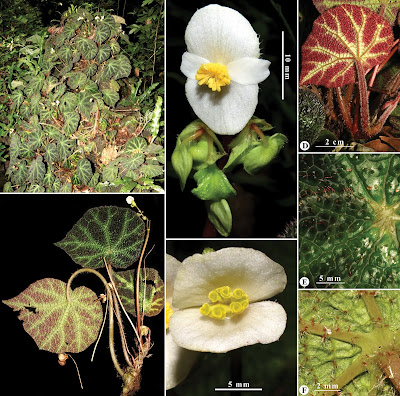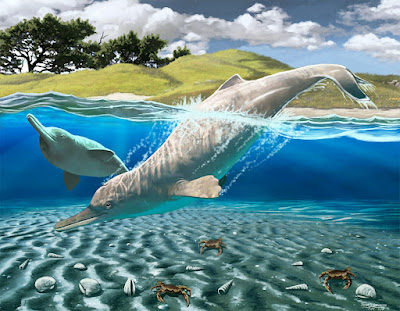[Most Recent Entries] [Calendar View]
Tuesday, September 6th, 2022
| Time | Event | ||
| 8:35a | [Mollusca • 2021] Pila mizoramensis • A New Species of Pila (Gastropoda: Ampullariidae) from Mizoram, India
ABSTRACT Family Ampullariidae consists of 11 genera of freshwater snails distributed pan-tropically in the Old and the New World. One of the ampullarid genera, Pila, is distributed in Africa and Asia and consists of 28 species. Here we describe the sixth member of the genus Pila from India. Pila mizoramensis n. sp. was collected from the Northeast Indian state of Mizoram. We adopted an integrative taxonomic approach to describe this species. First, a multilocus phylogeny of the genus was built to determine its placement in the tree. Then we used pairwise distance in the cytochrome oxidase I gene to compare its divergence from its congeners. Finally morphometric data was used to show that this hill stream species of Pila does not overlap with other hill stream species in morphometric space. The morphology of the species is also discussed in detail. With the advent of molecular tools in taxonomy a plethora of new species have been described from India in the last few decades. We add this newest member of genus Pila to the growing list. KEYWORDS: Endemicgastropod, hill stream, hotspot, integrative taxonomy, NE India, species discovery Maiterya Sil, Reshma Basak, K. Praveen Karanth and Neelavara Ananthram Aravind. 2021. A New Species of Pila (Gastropoda: Ampullariidae) from Mizoram, India. Molluscan Research. 41(3); 204-213. DOI: 10.1080/13235818.2021.1941575 | ||
| 8:46a | [Botany • 2021] Begonia catbensis (Begoniaceae, section Coelocentrum) • A New Species from northern Vietnam
Abstract Begonia catbensis, a new species in Begonia sect. Coelocentrum is described and illustrated. The new species was discovered in lowland limestone hills at Cat Ba National Park and can be easily distinguished from all its congeners by having dendritic hairs on the petiole, adaxial veins and stipules, fimbriate bracts and bracteoles, dense conical bullae on the upper surface of the leaf blade, two tepals in the pistillate flowers and a glabrescent ovary with verrucose wings. Based on IUCN Criteria, the species is currently assessed as “Endangered” (D). Keywords: Begonia, Cat Ba, endangered plant, new species, Vietnam Begonia catbensis L.N.Dong, K.S.Nguyen & Y.M.Shui, sp. nov. Diagnosis: Morphologically similar to several Begonia having conically bullate leaves and others with a rugulose leaf surface with white maculation and a ciliolate tepal margin, but can be easily distinguished from them by the dendritic hairs on the petioles, abaxial veins and the keeled mid-rib of the stipules, glabrous peduncles, pistillate flowers with 2 tepals and glabrescent ovaries with verrucose wings. Li-Na Dong, Khang Sinh Nguyen, Yu-Min Shui, Hieu Quang Nguyen, Wei‑Bin Xu and Xuan Khu Nguyen. 2021. Begonia catbensis (sect. Coelocentrum, Begoniaceae), A New Species from northern Vietnam. PhytoKeys. 179: 1-12. DOI: 10.3897/phytokeys.179.65812 | ||
| 1:04p | [PaleoMammalogy • 2022] Unravelling the Identity of the platanistoid Notocetus vanbenedeni Moreno, 1892 (Cetacea: Odontoceti) from the early Miocene of Patagonia (Argentina)
Abstract Platanistoidea remains one of the most evolutionarily intriguing lineages of toothed whales (Odontoceti). The clade comprises mostly extinct species from the late Oligocene–early Miocene onward and a single extant riverine genus (Platanista). There is an ongoing debate as to the membership of Platanistoidea and the causes of their near extinction. In Patagonia (Argentina), the most abundant platanistoid recorded in the lower Miocene Gaiman Formation is Notocetus vanbenedeni, first described by Moreno in 1892 based on two individuals. The goal of the present contribution is to conduct an updated anatomical, palaeobiological and phylogenetic analyses of Notocetus vanbenedeni and hence contribute to an understanding of the evolutionary history of the Platanistoidea. Our analyses, including at least 26 individuals (12 undescribed), show that Notocetus vanbenedeni is a valid platanistoid taxon, recovered as part of a new clade. Among its most outstanding features, this taxon has an elevated dorsal tubercular supraorbital crest formed mainly by the frontal, the precursor of the pneumatized crest of the extant Platanista. Notocetus vanbenedeni also shows initial stages of the plesiomorphic bony connection between the earbones and skull as in Platanista, although the functional implications for hearing remain elusive. The nasal sac system, pterygoid sinus system and morphology of the earbones suggest that this species was able to hear high-frequency sounds and echolocate underwater, similar to extant odontocetes. Thus, Notocetus vanbenedeni presents a mosaic of features that suggest an intermediate platanistoid morphotype. Anatomical differences and phylogenetic analyses suggest that Peruvian specimens could not be referred to this species. The feeding apparatus of Notocetus vanbenedeni makes it the only combination suction-feeder recorded in the early Miocene of Patagonia and among the smallest odontocetes. Finally, the abundant records of Notocetus vanbenedeni in an inner shelf environment with freshwater influence suggest a possible early preference for such protected habitats. Keywords: evolution, Platanistoidea, palaeobiology, Odontoceti, time-calibrated phylogenetic hypothesis, Gaiman Formation Mariana Viglino, Mónica Romina Buono, Yoshihiro Tanaka, José Ignacio Cuitiño and Robert Ewan Fordyce. 2022. Unravelling the Identity of the platanistoid Notocetus vanbenedeni Moreno, 1892 (Cetacea, Odontoceti) from the early Miocene of Patagonia (Argentina). Journal of Systematic Palaeontology. 20(1): 2082890. DOI: 10.1080/14772019.2022.2082890 |
| << Previous Day |
2022/09/06 [Calendar] |
Next Day >> |











